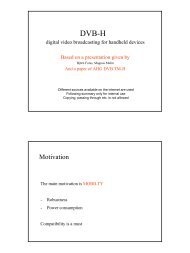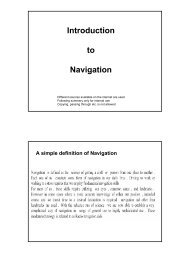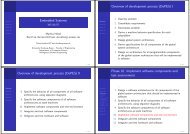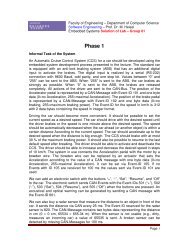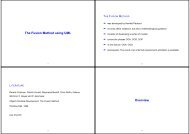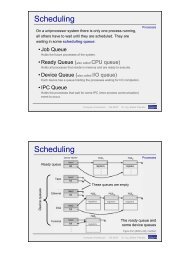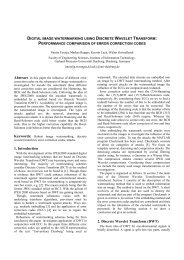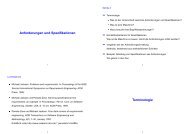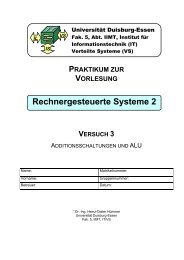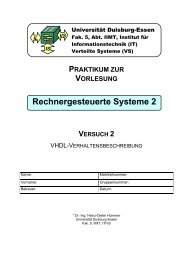Design Patterns
Design Patterns
Design Patterns
Create successful ePaper yourself
Turn your PDF publications into a flip-book with our unique Google optimized e-Paper software.
ADVANTAGES OF DESIGN PATTERNS (TICHY)<br />
• Improvement of team communication<br />
<strong>Design</strong> pattern as “short formula” in discussions<br />
• Compilation of essential concepts, expressed in a concrete form<br />
• Documentation of the “state of the art”<br />
Help for less experienced designers, not constantly reinventing the wheel<br />
• Improvement of the code quality<br />
Given structure, code examples<br />
DESCRIPTION OF DESIGN PATTERNS (GOF) (2)<br />
Collaborations How do the participants collaborate to carry out their<br />
responsibilities?<br />
Consequences What are the trade-offs and results of using the pattern?<br />
What aspect of system structure does it let one vary independently?<br />
Implementation What pitfalls, hints, or techniques should one be aware of<br />
21<br />
when implementing the pattern? Are there any language-specific issues?<br />
Sample Code Code fragments in C ++ or Smalltalk.<br />
Known Uses At least two examples of applications taken from existing<br />
systems of different fields.<br />
Related <strong>Patterns</strong> Similar patterns and patterns that are often used in<br />
combination with the described pattern.<br />
23<br />
DESCRIPTION OF DESIGN PATTERNS (GOF) (1)<br />
Name and Classification A good name is important, because it will become<br />
part of the design vocabulary.<br />
Intent What does the pattern do? Which problems does it solve?<br />
Also Known As Other familiar names.<br />
Motivation Scenario which illustrates the design problem and how the pattern<br />
solves the problem.<br />
Applicability What are the situations in which the design pattern can be<br />
applied? How can one recognize these situations?<br />
Structure Class and interaction diagrams.<br />
Participants Classes and objects, which are part of the pattern, as well as<br />
their responsibilities.<br />
MODEL-VIEW-CONTROLLER (MVC)<br />
• Architectural Style a /<strong>Design</strong> Pattern b -Hybrid<br />
• aggregate design pattern out of<br />
– Composite<br />
– Observer<br />
– Strategy<br />
– Factory Method<br />
22<br />
• Clear distinction of data (model), data representation on a screen (view)<br />
and control of data manipulation or views (controller)<br />
a Buschmann et al. – Pattern-Oriented Software Architecture – A System of <strong>Patterns</strong>, John<br />
Wiley & Sons, 1996.<br />
b GoF<br />
24



